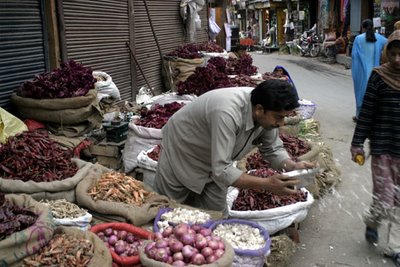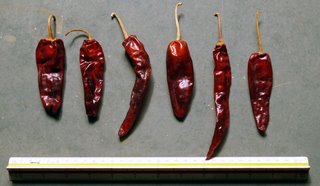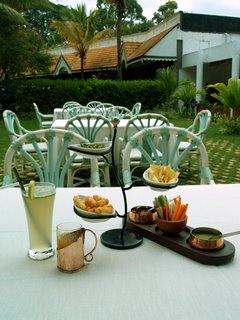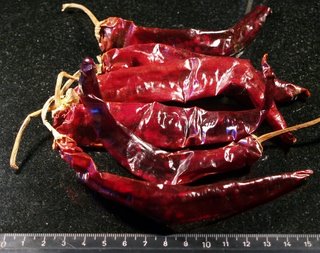Have you ever seen a recipe where Kashmiri chillies were called for?
I've seen lots, recipes that is, that call for Kashmiri chillies, all suggesting that they are essential because they are very red and very mild tasting, having virtually none of the pungent bite we expect from these fruit.
Are Kashmiri chillies very red and non-pungent? I decided to find out for myself. I couldn't get a reliable source of Kashmiri chillies in the UK, and after buying several packets, all labelled 'Kashmiri chillies' and all containing fruit of different shapes and sizes (which I could identify as not being Kashmiri), I realised that the only thing to do was go to India and find some there.
As Kashmir (well Kashmir and Jammu is the official name of the state) is in somewhat of a sticky situation, at the moment, and not wishing to add to the British Consulate's missing persons list, I decided to visit an Indian friend in Bangalore who had recently returned from Kashmir, with chillies bought from a stall in a street market.....

Above is a photo of the very stall from which the chillies were bought, from the white sack just infront of the stall keeper, also in sacks are red onions, garlic, praan (a type of garlic shallot), more chillies, and a red/purple flower, mawal, also known as 'cock's comb' in the UK.
My gourmet friend in Bangalore let me look at the chillies he had brought back from Kashmir, I found that there were several different shapes of chillies in the bag, though none were bright red. I started to arrange them in order, which ranged from long pointed ones to short rounded ones. In all, I estimated there were 21 different shapes, and I trawled through the whole bag of about 300 chillies trying to determine the commonest shapes and sizes. The result I obtained was literally a mixed bag! Five shapes were common, but these too ranged from long and thin to short and rounded. No real conclusion there. Was one of these the real thing?

One day, my gourmet friend took me to lunch at the West End Hotel, one of the group of Taj Hotels, famous throughout India.

The beginnings of a memorable meal, in the copper clad glass is South Indian rasam, and in the tall glass some mausambi juice, behind some pre-lunch nibbles.

My friend (left, above) introduced me to the Executive chef (right), who had a tasting menu prepared just for us, and he sat with us so that we could talk while we ate our Kashmiri kababs and mutton rogan josh. He said he was from Kashmir, so I asked him what he considered a true Kashmiri chilli should look like. As I had my camera with me with the pictures of all the different shapes of chillies, I asked him to point to the ones he thought were true Kashmiri. He pointed to the thin pointed ones, saying that these were what he thought of as Kashmiri chillies, the rounded ones were like those from neighbouring Jammu. I was a little surprised as I had thought the rounded ones nearer the mark as did my friend from Bangalore.
Earlier in the week we had had an evening meal at a Bombay-type restaurant, and again my friend introduced me to the chef. We were granted a look at his kitchens (though we had to wear chefs' tall hats!). As we were shown around the kitchens, we spotted a bowl of chillies, used only for garnish, we were told. The chef pointed to spherical ones and I suggested that they were a variety called 'mundu'. The chef agreed. He then pointed to the long thin ones, and called them Kashmiri chillies, but I knew they were not, they were long and pointed and red alright, but they were wrinkled, a characteristic of a variety of chilli grown in north Karnataka, which are known as 'byadgi' chillies. They were deep red and had no pungency whatsoever. Could this be what people thought was the 'Kashmiri chilli'?
So, I bought a big bag of 'Byadgi' chillies from a supermarket in Bangalore for about 25 pence, and another one of the 'mundu' round ones, my gourmet friend gave me some of his prized Kashmiri chillies, and another guy I met gave me some white 'Kanthari' chillies from his home state of Kerala. Now that I was armed with a selection, I could proceed with one of the recipes calling for 'Kashmiri chillies', the recipe is Mutton Rogan Josh.
Rogan Josh could be thought of as a signature dish of Kashmir. It is properly made with mutton, though in India, all the mutton is from the goat, not a sheep. The name Rogan Josh means 'warming fat', alluding to the fact that the dish is really mutton served in highly flavoured fat/oil. The flavours are characteristic of the area, and not from the usual spices one associates with Indian food. There is no coriander or cumin, fenugreek or mustard seed, there aren't any onions or garlic or fresh root ginger, there definitely isn't any tomato or coconut or fruit of any kind, the last three are figments of the UK 'Indian restaurant chef's' imagination.
The quintessential Rogan Josh contains only mutton, garam masala, ginger powder, fennel powder and yoghurt as a means of developing flavours, together with a spice called asafoetida, an evil smelling resin (asa means resin and foetida, well you work it out!)used in place of the onion and garlic, and those 'essential' Kashmiri chillies. SOme recipes for rogan josh also call for a flower extract to provide even more colour, but I'll pass on that one, and see what the chillies provide.
The meat is browned in ghee (which is clarified butter) with garam masala, a combination of very aromatic spices, and not the rather tame mix found in the local supermarket! The idea is to extract the flavours from the spices into the fat/oil, and then let them adsorb onto the meat. see http://cumbrianfoodlab.blogspot.com/
Strange how things turn out. A week after I returned from India, I went into the covered market in Barrow-in-Furness, a town where I work. There is a stall there run by a Thai lady selling, among other oriental food, Thai vegetables and fruit. I thought I would buy a selection, especially the Thai chillies, which are a good substitute for fresh red chillies to be used in Indian dishes. Also on sale were tiny green chillies, which the label said were 'Bird chillies' and then I spotted a packet of dried red chillies. I looked in the packet and they were medium red, about 200mm long and pointed. The Thai lady said they were used in Thai cooking for their red colour. Could these be 'Kashmiri chillies'? I rushed home and tried one, no pungency at all from the tip to about two thirds the way up and slight pungency when I got to the seeds and placenta (the webbing attached to the seeds, and where the pungency is located).

For all I could tell, these were 'Kashmiri chilles'. Did I just travel 15,000 miles to get chillies I could have bought in the next town?
[from the Simpsons' show about Mr. Burns' lost bear]....
Homer: "Marj', I'm confused, is this a good ending or a bad ending?"
Marj': "It's just an ending, that's enough!"
No comments:
Post a Comment